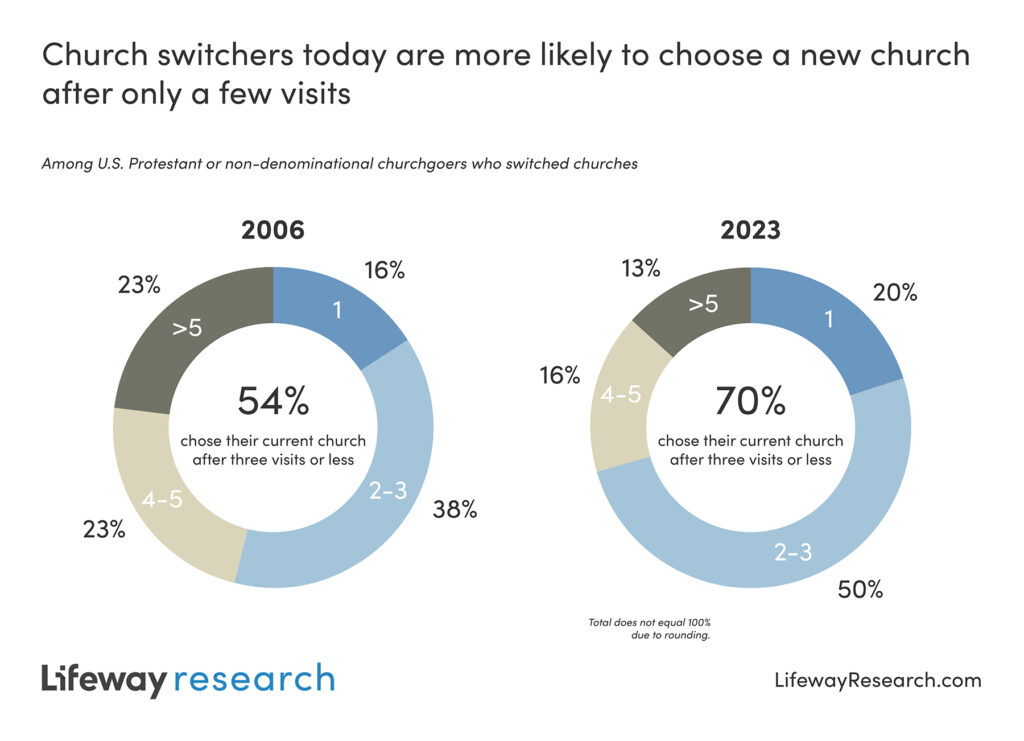Introductions to current church
Around 3 in 10 churchgoers who have changed congregations were first introduced to their current church because a friend or acquaintance invited them to attend (31%), they heard about it through word of mouth (29%) or a family member invited them to attend (27%). Others had always been familiar with the church (25%) or had driven by it before (23%). Fewer were first introduced to their church by finding the church website (15%), finding out about it on the internet (15%), seeing it on social media (10%), asking for recommendations online (8%), finding out about it from an ad (7%) or finding out about it through a media story (6%).
Church switchers who have made a residential move are more likely than those who have not to have been first introduced to their current church online—through the church website (20% v. 8%), the internet (19% v. 9%), social media (12% v. 6%) or online recommendations (11% v. 5%).
Among those who were first introduced to their church through the church’s website, more than 2 in 3 (67%) said the church’s beliefs and mission were the most helpful thing on the website. Churchgoers also found simple and practical information such as church location (66%) and worship times (64%) to be helpful. Others found ministries or events (50%), sermons (42%), contact information (39%), staff profiles (33%) and social media contacts (26%) to be helpful.
First visit
By far, when churchgoers are visiting a new church, the first event or activity they will likely attend is a worship service (68%). However, this is down from 2006 when nearly 9 in 10 (88%) said a worship service was the first thing they attended at their current church. Church switchers who are not making residential moves are more likely than those who are to attend a worship service first (73% v. 64%).
Fewer than 1 in 10 say the first event or activity they attended at their current church was a Bible study class or small group at the church (6%), a social get-together among church members (6%), a streamed worship service (5%), a Bible study class or small group in a home (4%), a class other than a Bible study that interested them (4%), a service ministry of the church (4%) or a musical event (2%).
Among the small sample who attended a streamed service first, 54% said they streamed worship services four or more times before visiting in person, with 15% saying they watched a streamed service four or five times and 39% saying they watched a service more than five times.
“A church’s worship service is still the front door of the typical church, but a third of first-time visitors will use a different door today,” McConnell said. “It is important that every ministry within a church realizes they may have the first contact with someone who needs a church.”
RELATED: Gen Z and Millennials Are Seeking Authentic Church Community, Not Leaving It
For more church switchers today than in 2006, it only takes a few visits to decide that’s the church they will attend regularly. Today, more than 7 in 10 (71%) decide to regularly attend their current church after visiting worship services three times or less. Half of churchgoers who changed churches (50%) said it took them two or three visits to decide, compared to 38% in 2006. And 20% say it took one visit, compared to 16% in 2006.
Welcomed or not
When visiting their current church, most church switchers say they were personally welcomed by congregants before or after the service (56%). Close to half say they were personally welcomed by pastors or ministers before or after the service (48%). More than a third were asked to fill out an information card by hand (36%). Fewer were invited to attend social events outside of service (23%), formally recognized during the service (19%), asked to fill out an information card electronically (12%), encouraged to introduce themselves (10%) or asked to text the church (6%). And 3% of churchgoers said they were not welcomed in any of these ways.
Church switchers today are less likely than those in 2006 to say they were personally welcomed by congregants (56% v. 67%), asked to fill out a card by hand (36% v. 62%) or contacted by a welcoming team (21% v. 28%). Switchers in 2006 were not asked about the option to provide information electronically or by text.


